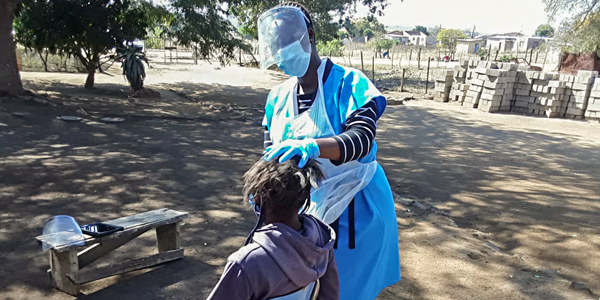Who catches and transmits flu in SA and the implications for vaccination
- Wits Communications
A new study has found a high burden of influenza in a rural and an urban setting in SA, where asymptomatic people – particularly children – transmit this virus.
Influenza (flu) causes approximately 300 000-600 000 respiratory deaths globally annually, with the highest rates in sub-Saharan Africa.
Data on influenza community burden and transmission are important to plan interventions especially in resource-limited settings.
However, data are limited, particularly on the symptomatic proportion by age and particularly from low-income and middle-income countries.
The study, by Wits scientists, the National Institute for Communicable Diseases (NICD), and colleagues at North West University and the US Centers for Disease Control and Prevention, was published in The Lancet Global Health on 18 May 2021.

“We aimed to evaluate the community burden and transmission of influenza in a rural and an urban setting in South Africa,” says lead author Cheryl Cohen, Professor of Epidemiology in the Wits School of Public Health and Head of the Centre for Respiratory Disease and Meningitis at the NICD in South Africa’s National Health Laboratory Service. “Understanding the community burden and transmission of seasonal influenza is paramount to guide the use of vaccination and non-pharmaceutical interventions and may inform pandemic preparedness.”
Led in the North West Province by the Wits Perinatal HIV Research Unit (PHRU) and in Mpumalanga by the MRC/Wits Rural Public Health and Health Transitions Research Unit (Agincourt), the research provides important data on community burden of flu and flu transmission in an African setting and contributes important findings on symptomatic versus asymptomatic flu transmission by age group.
Harish Nair, Professor of Paediatric Infectious Diseases and Global Health, University of Edinburgh, in a comment in The Lancet Global Health wrote that the study “makes a valuable contribution to our hitherto poor understanding of respiratory viruses, like respiratory syncytial virus and influenza, that cause substantial disease burden in populations, particularly those at the extremes of age. That the study was done in a high HIV burden setting, South Africa, helps to understand disease transmission and the differential effect of respiratory infections in individuals with and without HIV.”
About the study
Titled Elevated community burden and asymptomatic transmission of seasonal influenza in an urban and a rural community in South Africa, 2017-2018: results of the PHIRST cohort study, the research evaluated community burden and transmission of influenza in rural Agincourt in Mpumalanga and in urban Klerksdorp, Northwest Province, during 2017 and 2018.
Approximately 100 randomly selected households were enrolled annually and followed for 10 months.
Data were collected through systematic twice-weekly nasopharyngeal [the upper part of the throat, behind the nose] swabs of all household members regardless of whether they showed symptoms.
Samples, presence of symptoms and healthcare seeking information, were collected at each visit, for 10 months of each year and samples were tested for the presence of influenza by a PCR [Polymerase chain reaction] test. The researchers acknowledge with gratitude the household participants who consented to and permitted these twice weekly swabs.
Of the 81 430 samples collected from 1 116 participants in 225 households, 917 (1%) tested positive for influenza and 79% of households (178/225) had more than one influenza-positive individual.
Asymptomatic individuals may drive transmission
“The high burden of asymptomatic influenza infections in the community, together with the fact that asymptomatic individuals transmit influenza to approximately 6% of household contacts suggests that asymptomatic individuals may be an important driver of influenza transmission,” says Professor Kathleen Kahn, senior scientist at Agincourt.
Transmission highest among children
Young children also experienced the highest burden of flu infection and symptomatic illness and were more likely to spread flu to their household contacts compared with other age groups.
The data show that the proportion of symptomatic infections was higher in children older than 5-years-old: 74% in this age group versus 39% in adults aged 19-44 years.
Dr Neil Martinson of PHRU says, “These data have implications for the use of non-pharmaceutical interventions and vaccination strategies targeting children to prevent influenza transmission.”
Vaccination implications
In this study, approximately half of influenza infections were symptomatic, with asymptomatic individuals transmitting influenza to 6% of household contacts.
This suggests that strategies, such as quarantine and isolation, might not be effective in controlling influenza.
Thus, vaccination of children, with the aim of reducing influenza transmission, might be effective in African settings, given the young population and high influenza burden.
In South Africa influenza vaccination is recommended for individuals at high risk of severe outcomes including the elderly, pregnant women, and HIV-infected adults.
However, due to limited resources to procure vaccines, coverage remains low.
Vaccination strategies that target community influenza transmitters (such as children) may be more cost effective than risk-group based vaccination strategies, particularly in settings such as South Africa where vaccination rates and care seeking in high risk groups remain low.
A similar study currently underway in the same study sites aims to estimate the community burden and transmission of SARS-CoV-2, the respiratory virus that causes Covid-19.

